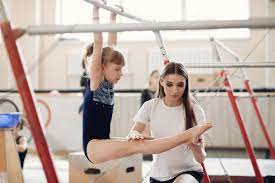Gymnastics for kids is one of the most well-rounded activities a child can engage in. It builds physical strength, boosts confidence, and lays the groundwork for lifelong fitness. More than just cartwheels and balance beams, recreational gymnastics offers developmental benefits that support kids in all areas of life—physically, socially, and mentally.
Whether your child is flipping into foam pits or just learning how to roll and stretch, the benefits go far beyond the gym floor.
What is recreational gymnastics for kids?
Recreational gymnastics for kids refers to non-competitive programs designed to help children build coordination, balance, strength, and flexibility in a fun, encouraging environment. Classes typically involve tumbling, beam work, vaulting, and floor exercises—but without the pressure of scoring or elite competition.
It’s perfect for beginners and young learners who want to stay active, learn new skills, and make friends along the way.
How does gymnastics support physical development?
Gymnastics is a full-body workout disguised as play. Through routines and drills, kids develop:
- Core strength from stabilising on beams or holding body positions
- Flexibility from stretching, splits, and dynamic movements
- Balance and coordination from beam work, jumping drills, and rotations
- Fine and gross motor skills that support everyday movements and posture
Physical literacy in early childhood is crucial for long-term health. Gymnastics trains these abilities while children have fun—an ideal recipe for consistent participation and long-term engagement.
What mental and emotional benefits does gymnastics provide?
Gymnastics for kids isn’t just about muscles—it builds mental muscle too. Learning how to attempt (and sometimes fail at) new skills helps kids develop:
- Resilience and perseverance—getting up after a fall teaches emotional regulation
- Self-discipline—kids learn to follow instructions, wait their turn, and work on technique
- Confidence—mastering a cartwheel or landing a handstand gives a real sense of achievement
According to research published by the Australian Sports Commission, regular participation in sport is linked to improved self-esteem and lower anxiety levels in children.
How does gymnastics promote social growth?
Recreational gymnastics is a highly interactive environment. While kids focus on their own progress, they’re also:
- Encouraged by peers
- Cheered on by coaches
- Supported by friends during group activities
This shared encouragement helps develop empathy, listening skills, and a sense of community—especially valuable in the formative years. It also makes the gym a place kids want to return to, week after week.
Why is consistency important for young gymnasts?
Cialdini’s principle of Consistency plays a quiet yet powerful role in recreational gymnastics. As children commit to weekly classes, they build a sense of identity: “I’m a gymnast.” That self-perception fuels motivation, goal-setting, and accountability—skills that carry over to school, relationships, and future responsibilities.
With each session, progress becomes a habit—and that habit leads to greater results.
Is gymnastics safe for young children?
Yes—when properly supervised, gymnastics is one of the safest sports for kids. Accredited programs follow strict safety protocols, use padded equipment, and offer age-appropriate instruction.
Recreational classes focus on foundational skills that are low-impact and progressive. Children start with rolls, stretches, and safe landings before ever attempting more advanced movements.
The emphasis is on control and progression, not risk.
Can gymnastics help with school performance?
Surprisingly, yes. Gymnastics teaches concentration, pattern recognition, and memory—all key skills that support classroom learning. From remembering routines to reacting quickly during drills, kids practise mental focus in a physical setting.
Over time, this can help:
- Improve attention span
- Enhance problem-solving ability
- Foster creative movement and spatial awareness
It’s no coincidence that many high-performing students also participate in structured physical activities like gymnastics.
What age is best to start gymnastics?
Kids can start gymnastics as early as 18 months through parent-assisted programs. Independent classes generally begin around age 3 or 4, with structured lessons becoming more focused for kids aged 5 and up.
The earlier kids start, the more comfortable they become with movement, confidence, and motor skill development. But it’s never too late—children can benefit at any age.
Why do parents choose recreational gymnastics?
For many families, gymnastics is the perfect balance of fun, fitness, and structure. Parents often cite:
- Reliable routines and schedules
- Qualified, friendly coaches
- Clear progressions and achievements
- A supportive, screen-free environment
It’s one of the few activities that supports the whole child—not just their body or their mind, but both working in harmony.
Frequently Asked Questions
Is gymnastics for kids suitable for children with special needs?
Yes. Many programs offer inclusive classes with trained staff and adaptive techniques to support kids of all abilities.
How long should my child stay in gymnastics?
There’s no set timeline. Some kids enjoy recreational gymnastics for years, while others move into competitive or complementary sports. The key is consistent enjoyment and growth.
Do boys do recreational gymnastics too?
Absolutely. Gymnastics builds athletic foundations for all genders. Many boys enjoy the strength and agility training, especially as a base for other sports like footy or basketball.
Final thoughts
Whether your child dreams of somersaults or just loves bouncing around, gymnastics for kids is one of the most comprehensive and enjoyable ways to support their development. The physical, emotional, and social benefits stack up over time—making every roll, stretch, and jump part of a bigger journey.
And if you’re looking to explore other fun fitness programs, indoor sports programs for kids also offer exciting ways to stay active and connected year-round.

